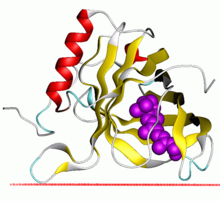Lipocalin

|
|||||||||
| Identifiers | |||||||||
|---|---|---|---|---|---|---|---|---|---|
| Symbol | Lipocalin | ||||||||
| Pfam | PF00061 | ||||||||
| Pfam clan | CL0116 | ||||||||
| InterPro | IPR000566 | ||||||||
| PROSITE | PDOC00187 | ||||||||
| SCOP | 1hms | ||||||||
| SUPERFAMILY | 1hms | ||||||||
| OPM superfamily | 52 | ||||||||
| OPM protein | 1kt6 | ||||||||
|
|||||||||
| Available protein structures: | |
|---|---|
| Pfam | structures |
| PDB | RCSB PDB; PDBe; PDBj |
| PDBsum | structure summary |
| Lipocalin-like domain | |||||||||
|---|---|---|---|---|---|---|---|---|---|

Structure of the Escherichia coli lipocalin.
|
|||||||||
| Identifiers | |||||||||
| Symbol | Lipocalin_2 | ||||||||
| Pfam | PF08212 | ||||||||
| Pfam clan | CL0116 | ||||||||
| InterPro | IPR013208 | ||||||||
|
|||||||||
| Available protein structures: | |
|---|---|
| Pfam | structures |
| PDB | RCSB PDB; PDBe; PDBj |
| PDBsum | structure summary |
The lipocalins are a family of proteins which transport small hydrophobic molecules such as steroids, bilins, retinoids, and lipids. They share limited regions of sequence homology and a common tertiary structure architecture. This is an eight stranded antiparallel beta-barrel with a repeated + 1 topology enclosing an internal ligand binding site.
These proteins are found in gram negative bacteria, vertebrate cells, and invertebrate cells, and in plants. Lipocalins have been associated with many biological processes, among them immune response, pheromone transport, biological prostaglandin synthesis, retinoid binding, and cancer cell interactions.
Lipocalin proteins are involved in inflammation and detoxification processes caused by immune system activation in mammals. They are known respiratory allergens of mice, cats, dogs, horses, and other animals. Examples of lipocalin proteins involved in immune system responses include alpha-1-microglobulin, alpha-1-acid glycoprotein, and C8gamma. Structural information for many immune system influencing lipocalin proteins is available, while their exact role in biological systems is still somewhat unclear. Lipocalin allergens have been shown to evoke an Th2-deviated immune response, important for allergic sensitization, when applied in their apo-form (with an empty calyx devoid of ligands), whereas the holo-form seemed to exert immune-suppressive properties in vitro.
The lipocalin family has been connected with the transport of mammalian pheromones due to easily observable protein-pheromone interactions. Lipocalins are comparatively small in size, and are thus less complicated to study as opposed to large, bulky proteins. They can also bind to various ligands for different biological purposes. Lipocalins have been detected as carrier proteins of important pheromones in the nasal mucus of rodents. Major urinary proteins, a lipocalin subfamily, are found in mouse and rat urine and may act as protein pheromones themselves.
...
Wikipedia
